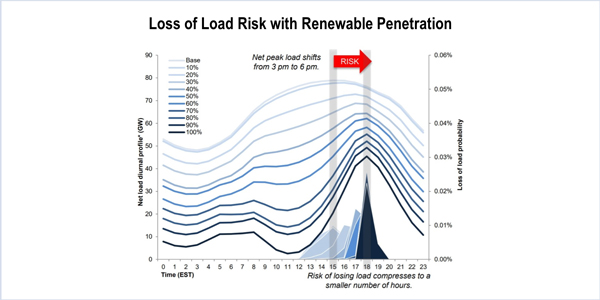By Amanda Durish Cook
Increased renewable integration, especially solar generation, will shift MISO’s peak load to evening hours, with a spikier but shorter daily loss-of-load risk, according to the initial results of the RTO’s new long-term renewable study.
Senior Policy Studies Engineer Jordan Bakke said the study, which has thus far focused only on resource adequacy, found distinct trends as renewable penetration was dialed up by increments of 10% of the resource mix:
- The average daily loss-of-load expectation (LOLE) becomes heightened, though it compresses to a smaller window later in the day;
- Wind and solar resources are less likely to be able to meet the late-day risk owing to their operational characteristics; but
- Geographically dispersed and diverse technologies like demand response and storage can assist renewables in their ability to meet load.
“We found strong evidence that the sun-down part of the day becomes high-risk hours,” Bakke told stakeholders at an April 18 Planning Advisory Committee meeting.
MISO’s multiyear Renewable Integration Impact Assessment, announced last year, seeks to identify “inflection points” where the growth of renewables and the retirement of baseload units will require changes in the structure or operation of the system.
The study aims to predict how and when reliability will be impacted under heavy renewable output; if there are limits to the amount of wind and solar generation MISO can support; how long before energy storage becomes a requirement; what parts of the grid will be stressed first; and how much renewable energy can be deployed before significant system changes are needed. (See MISO to Conduct Long-Term Renewable Integration Study.)
MISO studied an ever-increasing renewable penetration in the footprint, topping off at 100% using a mix of 75% wind, 17.5% utility-scale solar and 7.5% distributed solar.
Bakke said even with a small solar penetration increase, net peak load will shift from 3 p.m. to 6 p.m. MISO currently has 270 MW of installed solar.
“We’re seeing some dramatic shifts with relatively low levels of penetration,” Bakke explained. “What we’re seeing here is even when solar is at 5% penetration, this time shift already occurs … as solar drops off early in the evening.”
Bakke also said while MISO’s average year-round risk of losing load peaks from “noon to late in the day,” the risk period narrows to 5 to about 8 p.m. as more renewables are employed.
Some stakeholders set into an M.C. Escher-esque discussion on the change in loss-of-load risk, saying that while rising solar generation could cause a shift in the traditional peak load pattern, the traditional 3 to 6 p.m. peak demand hours do still exist — albeit muted by increasing solar supply. Some pointed out that a late-day loss-of-load risk falls to hours that historically have had less electricity demand and could be manageable.
Wind on the Wires’ Natalie McIntire asked if MISO’s study included a scenario in which increasing use of energy storage offsets the sharper loss-of-load risk.
Although MISO’s study indicates that storage can help offset the risk, Bakke said MISO used existing levels of non-renewable resources for the study and did not run scenarios with escalating use of energy storage. Customized Energy Solutions’ David Sapper said storage scenarios would have been “fundamental” to the early stage of the study.
MISO’s early results also show that a 100% renewables scenario can force negative loads during the day, meaning some generation must be curtailed or exported, Bakke said.
But some stakeholders said the need to plan for daytime negative loads is decades away, if it ever happens.
“We have a long way to go to get to 100% renewables, if we ever do. We need to focus on 10, 20, 30 years out,” McIntire said.
Bakke agreed, but said, “It’s important to look at these things early and often” because just a small increase in solar shows MISO may have to reallocate generation and load.
MISO found that wind and solar combinations do work symbiotically over an average day, especially in summer, with mid-day solar able to offset small dips in mid-day wind generation.
“They are not the perfect complement to each other, but they do complement one another,” Bakke said.
MISO plans to continue the renewable study on an open-ended basis; the RTO said it will continue to study resource adequacy under increasing renewables through the end of the year.
MTEP Resource Siting
In a related matter, Bakke said MISO’s 2019 Transmission Expansion Plan resource siting forecasts have been retooled this year to account for renewable adoption. Resource siting will rely on predictions of future energy storage sited at MISO’s busiest load buses; MISO predictions on electric vehicle adoption; National Renewable Energy Laboratory predictions on distributed resources; and the usual study from Vibrant Clean Energy that identifies areas ripe for utility-scale wind and solar development. MISO will reveal a first draft of MTEP 19 resource siting in September. (See Renewables, Storage Get More Play in MISO 2019 Planning.)
Meanwhile, the Planning Advisory Committee in June will begin to flesh out how to analyze and recommend energy storage as baseline reliability solutions in the MTEP process, a responsibility passed to it by the Energy Storage Task Force last month. PAC Chair Jeff Webb said MISO may have to submit Tariff changes with FERC to allow storage projects to be considered for reliability purposes.
Webb said staff and stakeholders have until Sept. 15 to propose reliability projects for MTEP 19. Some stakeholders have requested MISO allow storage projects to be submitted as baseline reliability projects in MTEP 19.




